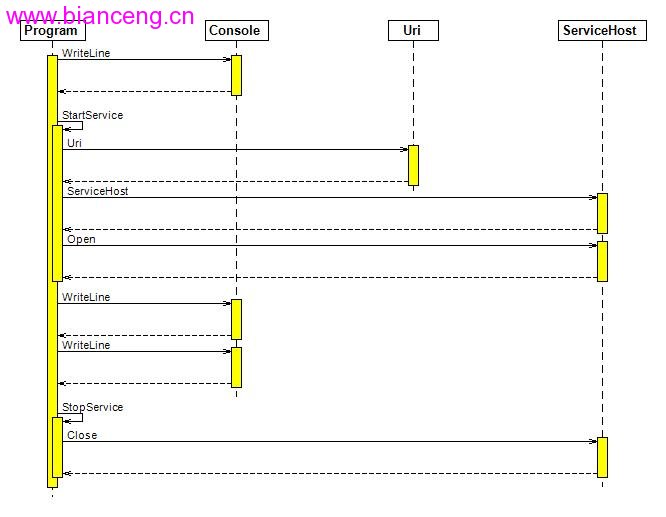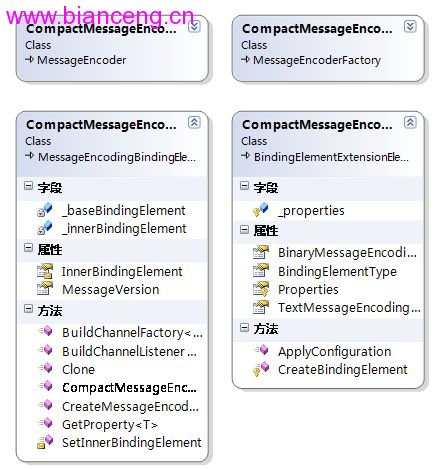本文及程序不是介紹WCF怎麼用,而是研究如何在WCF通信時的通道兩端自動進行數據壓縮和解壓縮, 從而增加分布式數據傳輸速度。
而且,這個過程是完全透明的,用戶及編程人員根本不需要知道它的存在,相當於HOOK在兩端的一個 組件。可以使用中網絡帶寬較小的網絡環境中。當WCF在兩個實體間通訊的時候,便自動創建一個信息通道轉接通訊,這個消息包含數 據請求和相應。WCF使用特殊的編碼器將請求和響應數據轉換成一系列的字節。
我所帶的項目裡遇到大文件分布式傳輸問題,經過分析考慮采用WCF通道壓縮技術來解決此問題。執行 這樣的編碼是需要傳輸大文件(XML格式)由一台機器到另一台機器傳輸,而連接有速度限制。我不用寫一個特殊的函數邊壓縮 和邊解壓,而是配置傳輸通道可以做到這一點,這種方式壓縮可重復使用的任何契約。我發現自己編寫的消息編碼器是最簡單的方式 來實現功能,真正的問題是如何編寫信息編碼器,在MSDN上沒有找到任何關於此應用的實例。消息契約編碼器的想法是Hook連接兩端發 送和接收信息的渠道。程序是采用Microsoft Visual Studio 2008 WCF設計。

圖1 WCF消息通道編碼過程時序圖
發送方:代碼中加入方法,該方法及其參數的序列化成SOAP消息,消息編碼序列化的信息將成為一個 字節數組,字節數組發送傳輸層。
接收方:傳輸層接收字節數組,消息編碼器並行化字節數組到一條消息,該方法及其參數並行化到一 個SOAP消息,方法是被監聽的。
當加入壓縮信息編碼器,該方法要求有一點改變:
發送方:代碼中加入方法,該方法及其參數的序列化成SOAP消息,消息契約編碼讓其內在的信息編碼 序列的信息成為一個字節數組,
消息契約編碼壓縮的字節數組第二個字節數組,字節數組發送傳輸層。
接收方:傳輸層接收字節數組,消息契約編碼的字節數組解壓到第二字節數組,消息契約編碼讓其內 在的信息編碼化的第二個字節數
組消息,該方法及其參並行化到SOAP消息,方法是被監聽的。
這個消息契約編碼分為幾個類:
CompactMessageEncoder //這個類提供了信息編碼實施。
CompactMessageEncoderFactory //這個類是負責提供契約信息編碼實例。
CompactMessageEncodingBindingElement //這個類負責通道的協議約束規范。
CompactMessageEncodingElement //這個類使信息編碼通過增加應用程序配置文件。

圖2 消息通道編碼器靜態類圖
壓縮方法:契約消息編碼器是使用gzip壓縮的NET Framework范圍內執行的,是調用 System.IO.Compression.GZipStream名字空間類中。
加入引用CompactMessageEncoder.dll,修改app.config文件引用,應用程序必須要在客戶端和服務器 端。
壓縮緩沖代碼:
private static ArraySegment<byte> CompressBuffer(ArraySegment<byte> buffer,
BufferManager bufferManager, int messageOffset)
{
// Create a memory stream for the final message
MemoryStream memoryStream = new MemoryStream();
// Copy the bytes that should not be compressed into the stream
memoryStream.Write(buffer.Array, 0, messageOffset);
// Compress the message into the stream
using (GZipStream gzStream = new GZipStream(memoryStream,
CompressionMode.Compress, true))
{
gzStream.Write(buffer.Array, messageOffset, buffer.Count);
}
// Convert the stream into a bytes array
byte[] compressedBytes = memoryStream.ToArray();
// Allocate a new buffer to hold the new bytes array
byte[] bufferedBytes = bufferManager.TakeBuffer(compressedBytes.Length);
// Copy the compressed data into the allocated buffer
Array.Copy(compressedBytes, 0, bufferedBytes, 0, compressedBytes.Length);
// Release the original buffer we got as an argument
bufferManager.ReturnBuffer(buffer.Array);
// Create a new ArraySegment that points to the new message buffer
ArraySegment<byte> byteArray = new ArraySegment<byte>(bufferedBytes,
messageOffset, compressedBytes.Length - messageOffset);
return byteArray;
}
解壓緩沖代碼:
private static ArraySegment<byte> DecompressBuffer(ArraySegment<byte>
buffer, BufferManager bufferManager)
{
// Create a new memory stream, and copy into it the buffer to decompress
MemoryStream memoryStream = new MemoryStream(buffer.Array, buffer.Offset,
buffer.Count);
// Create a memory stream to store the decompressed data
MemoryStream decompressedStream = new MemoryStream();
// The totalRead stores the number of decompressed bytes
int totalRead = 0;
int blockSize = 1024;
// Allocate a temporary buffer to use with the decompression
byte[] tempBuffer = bufferManager.TakeBuffer(blockSize);
// Uncompress the compressed data
using (GZipStream gzStream = new GZipStream(memoryStream,
CompressionMode.Decompress))
{
while (true)
{
// Read from the compressed data stream
int bytesRead = gzStream.Read(tempBuffer, 0, blockSize);
if (bytesRead == 0)
break;
// Write to the decompressed data stream
decompressedStream.Write(tempBuffer, 0, bytesRead);
totalRead += bytesRead;
}
}
// Release the temporary buffer
bufferManager.ReturnBuffer(tempBuffer);
// Convert the decompressed data stream into bytes array
byte[] decompressedBytes = decompressedStream.ToArray();
// Allocate a new buffer to store the message
byte[] bufferManagerBuffer = bufferManager.TakeBuffer(decompressedBytes.Length +
buffer.Offset);
// Copy the bytes that comes before the compressed message in the buffer
argument
Array.Copy(buffer.Array, 0, bufferManagerBuffer, 0, buffer.Offset);
// Copy the decompressed data
Array.Copy(decompressedBytes, 0, bufferManagerBuffer, buffer.Offset,
decompressedBytes.Length);
// Create a new ArraySegment that points to the new message buffer
ArraySegment<byte> byteArray = new ArraySegment<byte>
(bufferManagerBuffer, buffer.Offset, decompressedBytes.Length);
// Release the original message buffer
bufferManager.ReturnBuffer(buffer.Array);
return byteArray;
}
改變服務端配置
加入消息契約編碼器之前app.config的實例:
<?xml version="1.0" encoding="utf-8" ?>
<configuration>
<system.serviceModel>
<services>
<service name="Server.MyService">
<endpoint
address="net.tcp://localhost:1234/MyService"
binding="netTcpBinding"
contract="Server.IMyService" />
</service>
</services>
</system.serviceModel>
</configuration>
加入消息契約編碼器後app.config的例子:
<?xml version="1.0" encoding="utf-8" ?>
<configuration>
<system.serviceModel>
<services>
<service name="Server.MyService">
<!-- Set the binding of the endpoint to customBinding -->
<endpoint
address="net.tcp://localhost:1234/MyService"
binding="customBinding"
contract="Server.IMyService" />
</service>
</services>
<!-- Defines a new customBinding that contains the compactMessageEncoding -->
<bindings>
<customBinding>
<binding name="compactBinding">
<compactMessageEncoding>
<!-- Defines the inner message encoder as binary encoder -->
<binaryMessageEncoding />
</compactMessageEncoding>
<tcpTransport />
</binding>
</customBinding>
</bindings>
<!-- Adds the extension dll so the WCF can find the compactMessageEncoding -->
<extensions>
<bindingElementExtensions>
<add name="compactMessageEncoding"
type="Amib.WCF.CompactMessageEncodingElement, CompactMessageEncoder, Version=1.0.0.0,
Culture=neutral, PublicKeyToken=null" />
</bindingElementExtensions>
</extensions>
</system.serviceModel>
</configuration>
客戶端配置變化
加入消息契約編碼器之前app.config的實例:
<?xml version="1.0"
encoding="utf-8" ?>
<configuration>
<system.serviceModel>
<client>
<endpoint
address="net.tcp://localhost:1234/MyService"
binding="customBinding"
bindingConfiguration="compactBinding"
contract="Client.IMyService" />
</client>
</system.serviceModel>
</configuration>
加入消息契約編碼器後app.config的例子:
<?xml version="1.0"
encoding="utf-8" ?>
<configuration>
<system.serviceModel>
<client>
<endpoint
address="net.tcp://localhost:1234/MyService"
binding="customBinding"
bindingConfiguration="compactBinding"
contract="Client.IMyService" />
</client>
<!-- Defines a new customBinding that contains the compactMessageEncoding --
>
<bindings>
<customBinding>
<binding name="compactBinding">
<compactMessageEncoding>
<binaryMessageEncoding/>
</compactMessageEncoding>
<tcpTransport />
</binding>
</customBinding>
</bindings>
<!-- Adds the extension dll so the WCF can find the compactMessageEncoding -->
<extensions>
<bindingElementExtensions>
<add name="compactMessageEncoding"
type="Amib.WCF.CompactMessageEncodingElement, CompactMessageEncoder, Version=1.0.0.0,
Culture=neutral, PublicKeyToken=null" />
</bindingElementExtensions>
</extensions>
</system.serviceModel>
</configuration>
這種壓縮方法,消息堵塞的幾率很小。使用CompactMessageEncoder在同一台機器運行客戶端和服務器 上可能會降低效率。
本文配套源碼:http://www.bianceng.net/dotnet/201212/785.htm